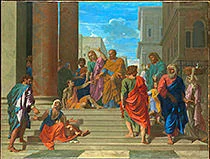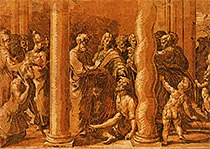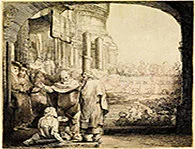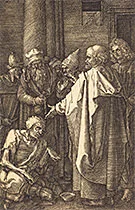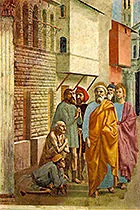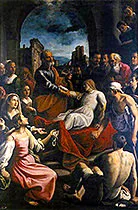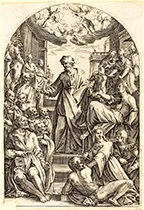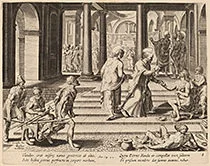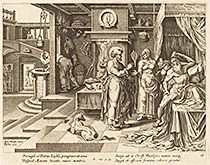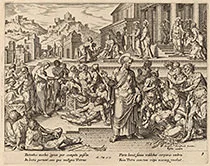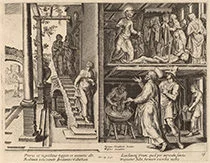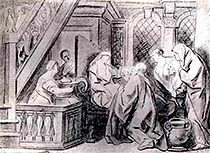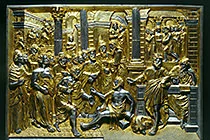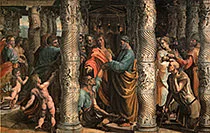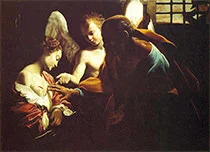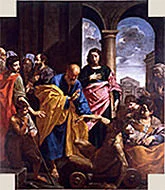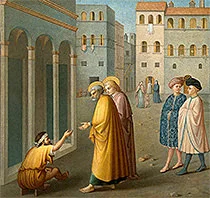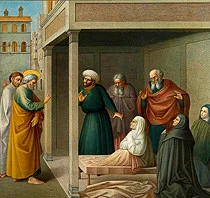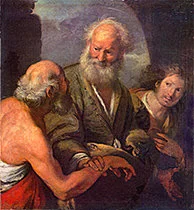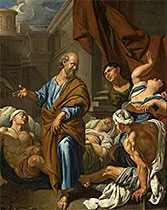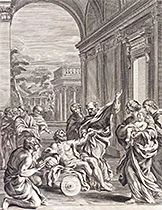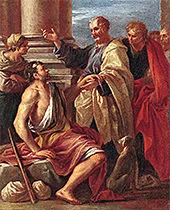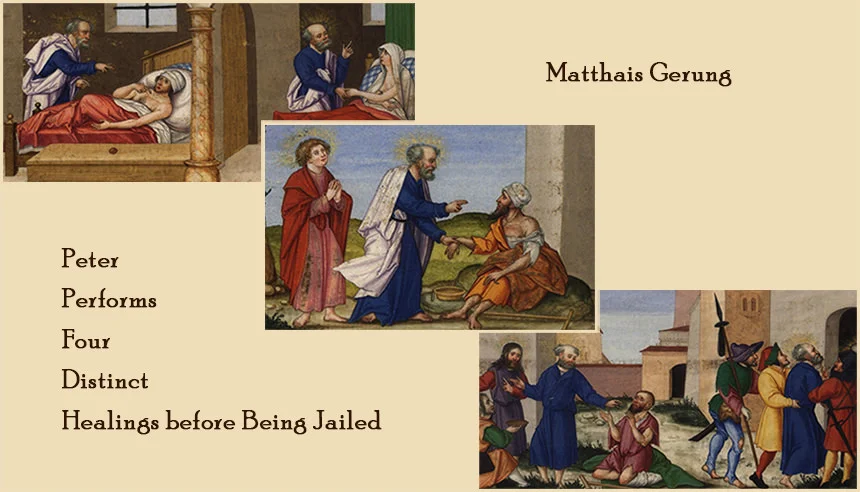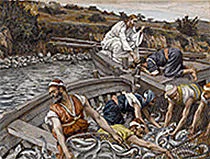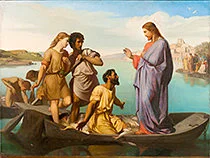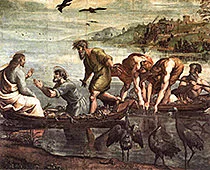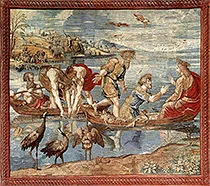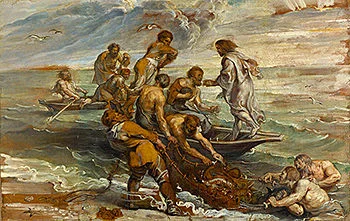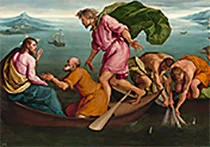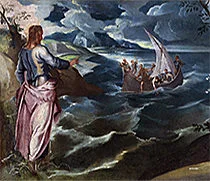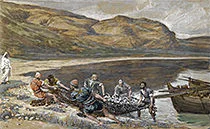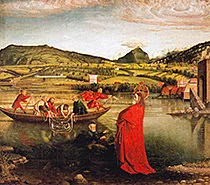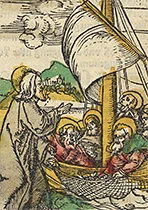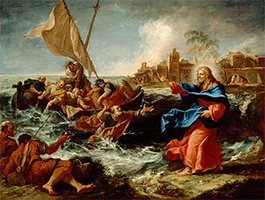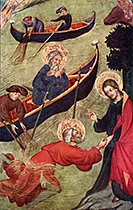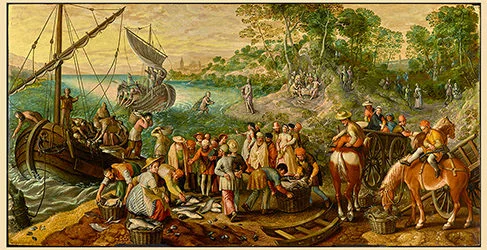The Art World Commemorates Peter
— Album 5 of 17 Photo Albums —
Warren Camp’s presentation of 550 famous “Peter” works of art includes historic paintings, frescoes, stained glass, etchings, sculptures, engravings, and other artwork monuments. They come from the Gothic (1100–1400), High Renaissance, Baroque, Rococo, Neoclassical, and Romantic (1800s) eras.
All are popular works, designed and created by celebrated artists, many of whom you’ll likely recognize, including Rembrandt, Raphael, Michelangelo, El Greco, Da Vinci, Masaccio, Huret, Galle, Tissot, Botticelli, Dürer, Rubens, and many more. They’ll bring back recollections of your “Art History 101” classes, using Janson’s History of Art textbook.
Whether depicting “Cephas,” “Petrus,” “Simon,” “Simeon,” “Simon Bar-Jonah,” “Simon Peter,” “The Rock,” “Peter,” “Apostle Peter,” or “Saint Peter,” the enlarged images of this acclaimed Bible figure come with factual and enlightening details: the artist’s bio; when each work was created; where it can be seen; applicable Bible passages; background and highlights of each work; and photo sources with copyright notices.
To appreciate the impact that Peter had on numerous art-world masters, be sure to click each thumbnail to enlarge it.
• These photo albums complement the Bible-study commentaries Warren has written for “1st and 2nd Peter,” found here.
…
Album 1 (Peter, alone) | Album 2 | Album 3 | Album 4 | Album 5
Album 6 | Album 7 | Album 8 | Album 9 | Album 10 | Album 11
Album 12 | Album 13 | Album 14 | Album 15 | Album 16 | Album 17
Album topics are shown at the [ ⇓ bottom ⇓ ] of each page.
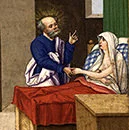
Peter Heals People
Healing the Cripples”
Slide 2
Click to enlarge.
Parmigianino — c. 1525
etching and engraving
the Cripple at the Gate”
Slide 3
Click to enlarge.
Rembrandt — 1659
etching and engraving
with His Shadow”
Slide 5
Click to enlarge.
Masaccio — 1426–1427
fresco painting
Healing the Lame Man”
Slide 13
Click to enlarge.
Umbrian — 1520–1580
gilded-silver plaque
The First Miraculous Catch of Fish (Luke 5:1–11)
The Second Miraculous Catch of Fish (John 21:1–14)
Miraculous Draft
of Fishes”
Slide 31
Click to enlarge.
James Tissot
1886–1894
opaque watercolor over graphite
on gray wove paper
Fishes by Saint Peter”
Slide 33
Click to enlarge.
Schäufelein — 1517
woodcut print
Draft of Fishes”
Slide 34
Click to enlarge.
Sebastiano Ricci
1695–1697
oil on canvas
- 1. “Saints Peter and John Healing the Lame Man,” painting by Nicolas Poussin, oil on canvas, 1655
“Saints Peter and John Healing the Lame Man” “At the temple in Jerusalem where the old and infirm beg for alms, Peter and John cure a man who cannot walk (Acts 3:1–10): Then Peter said, ‘Silver and gold I do not have; but what I do have I give you: In the name of Jesus Christ of Nazareth rise up and walk’ (v. 6).
“Nicolas Poussin was the leading painter of the classical French Baroque style, although he spent much of his working life in Rome. Most of his works were on religious and mythological subjects painted for a small group of Italian and French collectors… Though he had little formal education, Poussin became very knowledgeable in the nuances of religious history.”[1]
“Poussin’s measured composition is indebted to Raphael, while the gestures of the central group are reminiscent of Michelangelo’s Creation of Adam in the Sistine Chapel. This painting was executed in Rome for a merchant from Lyons.”[2]
“Simon Peter, also known as Cephas (John 1:42), was one Jesus’ first followers. He was an outspoken and ardent disciple, one of Jesus’ closest friends, an apostle, and a “pillar” of the church (Galatians 2:9). He was enthusiastic, strong-willed, impulsive, and, at times, brash. But for all his strengths, he had several failings in his life. Still, the Lord who chose him continued to mold him into exactly who He intended Peter to be.”[3]
… Height: 49 1/2 in. (125.7 cm), width: 65 in. (165.1 cm)
… Photo source, license, attribution, museum details, and image enlargement: The Met; The Marquand Fund, 1924
… The artist’s short biography; his other works of art
Return to “Peter Masterpieces” album’s opening page or to the top of this page or open the next album. - 2. “Saint Peter and Saint John Healing the Cripples,” etching and engraving by Parmigianino, c. 1525
Parmigianino’s “Saint Peter and Saint John Healing the Cripples” is a print that reproduces a composition related to Raphael’s tapestry cartoon of “The Healing of the Lame Man,” designed for one of the Sistine Chapel tapestries, c.1515–1516.
“At the temple in Jerusalem where the old and infirm beg for alms, Peter and John cure a man who cannot walk (Acts 3:1–10): Then Peter said, ‘Silver and gold I do not have; but what I do have I give you: In the name of Jesus Christ of Nazareth rise up and walk’ (v. 6).
“In this engraving based on a composition by Raphael, Parmigianino altered the proportions and placement of the figures, investing the work with the quivering vitality characteristic of him. Even when copying Raphael, Parmigianino does not imitate, but competes with his predecessor, striving to surpass him in refinement, showiness, and elegance.”[1]
Parmigianino’s composition shows Peter, center stage, with his large right hand that blesses a lame man whom he’ll order to stand up and walk. The man was instantly cured and miraculously able to walk. Next to Peter is John the apostle and evangelist who directs the lame man’s attention to Peter while witnessing this miracle. The temple columns divide the scene into three attentive segments.
… Photo source, license, attribution, museum details, and image enlargement: The Met; Harris Brisbane Dick Fund, 1927
… The artist’s short biography; his other works of art
Return to “Peter Masterpieces” album’s opening page or to the top of this page or open the next album. - 3. “Peter and John Healing the Cripple at the Gate,” etching and engraving by Rembrandt, 1659
Rembrandt Etching was first popularized in the 15th century, with artists such as Albrecht Dürer employing this artistic skill. By the 17th century, more artists were working with etchings; many, including Rembrandt, were attempting to refine the method.
However, what’s extraordinary about Rembrandt’s printmaking is how he experimented with ink and paper to produce noticeable differences from one plate-pressing to another — a revolutionary technique that ultimately made a lasting impact on the art of etching.
“Peter and John Healing the Cripple at the Gate” “This etching can be considered as a variant of his ‘John the Baptist Preaching’ painting. The action is the miraculous healing by Saint Peter, in the company of apostle Saint John, of a crippled beggar at the gate of the Temple.”[1]
Arriving at the temple gates, Peter and John encountered a beggar who’d been lame since birth. Peter addressed the man, saying that he could give him neither silver nor gold, but he would heal him in the name of Christ (Acts 3:1–10). The encounter between the two apostles and the lame man is part of the standard repertoire of illustrations from Acts of the Apostles.
… Height: 7 1/2 in. (19 cm), width: 8 3/4 in. (22.2 cm)
… Photo source, license, attribution, museum details, and image enlargement: The Met; bequest of Grace M. Pugh, 1985
… The artist’s short biography; his other works of art
Return to “Peter Masterpieces” album’s opening page or to the top of this page or open the next album. - 4. “Saint Peter and Saint John Healing a Cripple,” engraving by Albrecht Dürer, 1513
Albrecht Dürer “This second-to-last scene of the “Engraved Passion” (Dürer’s earliest work in the medium of engraving, all sixteen shown here) depicts a New Testament episode in the Acts of the Apostles (3:1–10), in which Peter and John heal a cripple begging outside the Beautiful Gate of the temple in Jerusalem. The cripple had been lame from birth.
“Saint Peter and Saint John Healing a Cripple” “Despite scholarly speculation that Dürer visited Florence during his second trip to Italy, this has never been proven. Yet he must have seen a copy of Masaccio’s fresco of ‘St Peter Healing a Cripple with His Shadow’ (c. 1427) in the Florentine church of the Carmine, since the composition of this engraving is so similar. Dürer’s mastery of classical form and monumentality are clearly evident.”[1]
Today considered one of the foremost artists of the Renaissance period, Albrecht Dürer’s extensive work in printmaking transformed the categorization of the medium from “craft” to “fine art.” Often depicting religious subjects, his woodcuts and engravings demonstrated unprecedented technical skill, tonal variation, and compositional sophistication. His skill earned him the role of court artist for Holy Roman Emperors Maximilian I and Charles V, under whom he created a number of paintings and altarpieces. Dürer’s series of self-portraits, created throughout his career, represent some of his most iconic works.
… Height: 4 5/8 in. (11.75 cm), width: 2 15/16 in. (7.46 cm)
… Photo source, license, attribution, museum details, and image enlargement: National Gallery of Art; Rosenwald Collection
… The artist’s short biography; his other works of art; Dürer’s collection of thirty-six “Small Passion” woodcuts and twelve “Large Passion” woodcuts
Return to “Peter Masterpieces” album’s opening page or to the top of this page or open the next album. - 5. “Saint Peter Heals the Sick with His Shadow,“ fresco painting by Masaccio, 1426–1427
Masaccio “This “Saint Peter Heals the Sick with His Shadow“ painting of Peter is an Italian fresco, painted as an altarpiece, typical of Masaccio’s work. The artwork illustrates the captivating presence of St Peter’s own shadow having the power to heal the sick. Masaccio presents Peter walking along while sick people wait at his side and honor him. What makes this fresco painting fascinating is St Peter’s solemn, meditative facial expression. There’s no sense that he acknowledges or considers the needs of the sick as he continues on. Interestingly, the two apostles walking behind Peter also look straight ahead.
“As evident through the title, the shadow of St Peter is prominent enough to heal the sick on its own. As the holy entity walks by the people, his internal spirit grants those around him back to health as they feel his presence upon them.”[1]
What was in Peter’s shadow that healed people? The biblical account can be found in Acts 5:15–16. “One thing we must note: Nowhere does the passage say that anyone was actually healed by being in Peter’s shadow. Neither does the passage tell us that the apostles ever commanded people to line the streets or condoned such actions. The only facts that we can draw from the wording of v. 15 are that people obviously had a high regard for Peter’s miracle-working and that they placed faith in the efficacy of even his shadow. Verse 16 does say people were healed at that time, but there is no indication that his shadow was the cause. In fact, the verse specifies that ‘all of them were healed’ — even those who were not under Peter’s shadow.”[2]
… Height: 90 1/2 in. (230 cm), width: 63 3/4 in. (162 cm)
… Photo source, license, attribution, image enlargement: public domain, via Web Gallery of Art; Cappella Brancacci, Santa Maria del Carmine, Florence
… The artist’s short biography; his other works of art
Return to “Peter Masterpieces” album’s opening page or to the top of this page or open the next album. - 6. “The Raising of Tabitha,” painting by Fabrizio Santafede, c. 1605
Fabrizio Santafede was an Italian painter known for his artistic altarpieces. “Tabitha, or Dorcas, in the Bible lived in the town of Joppa, a city on the coast of the Mediterranean Sea. Dorcas was also called Tabitha: Dorcas is a Greek name meaning ‘gazelle,’ and Tabitha is the Aramaic rendering of the same name. Dorcas, or Tabitha, was a charitable person who made things, especially clothing, for the needy in Joppa. The story of Dorcas in Acts 9 is notable because Peter raised her back to life after she had died.”[1]
Related Scripture: 36In Joppa there was a disciple named Tabitha (in Greek her name is Dorcas); she was always doing good and helping the poor. 37About that time she became sick and died, and her body was washed and placed in an upstairs room. 38Lydda was near Joppa; so when the disciples heard that Peter was in Lydda, they sent two men to him and urged him, “Please come at once!”
39Peter went with them, and when he arrived he was taken upstairs to the room. All the widows stood around him, crying and showing him the robes and other clothing that Dorcas had made while she was still with them.
40Peter sent them all out of the room; then he got down on his knees and prayed. Turning toward the dead woman, he said, “Tabitha, get up.” She opened her eyes, and seeing Peter she sat up. 41He took her by the hand and helped her to her feet. Then he called for the believers, especially the widows, and presented her to them alive. 42This became known all over Joppa, and many people believed in the Lord. 43Peter stayed in Joppa for some time with a tanner named Simon. — Acts 9:36–43 NIV
… Height: 10 ft. (306 cm), width: 80.7 in. (205 cm)
… Photo source, license, attribution, museum details, and image enlargement: Fabrizio Santafede, public domain, via Wikimedia Commons
… The artist’s short biography; his other works of art
Return to “Peter Masterpieces” album’s opening page or to the top of this page or open the next album. - 7. “Peter, Raising Tabitha,” engraved print by Jacques Callot, 1608–1611
Tabitha/Dorcas seems to have been a well-off widow living Joppa, always portrayed in artwork and commentary as a holy woman.
“Dorcas was a seamstress known for her good works and acts of love for the poor (Acts 9:36); she was much loved in the community of Joppa. When she became ill and died, the believers who knew Dorcas heard that Peter was in the nearby town of Lydda, and they sent for him. The Bible does not specifically say that the disciples at Joppa were hoping for Peter to resurrect Dorcas, but they did call urgently for him (v. 38). When Peter arrived at the home where Dorcas’ body had been laid out, he went up to see the body. There were many widows there, weeping. They all showed Peter ‘the robes and other clothing that Dorcas had made while she was still with them’ — tangible evidence of Dorcas’ loving service (v. 39). [Read this miraculous resurrection account in Acts 9:36–43.]
“What happened next is proof that our God is full of glorious, unrestrained power: ‘Peter sent them all out of the room; then he got down on his knees and prayed. Turning toward the dead woman, he said, ‘Tabitha, get up.’ She opened her eyes, and seeing Peter she sat up.” Bringing Dorcas back from the dead was not done for Dorcas’ sake — Peter knew she was in paradise, with Jesus, and that her life after death was preferable to her life on earth. Peter’s motive, at least in part, for raising Dorcas to life may have been for the sake of the widows and others in Joppa who needed the help Dorcas could provide. The resurrection of Dorcas was also a major reason so many people in Joppa believed. This miracle performed in the name of the Lord led many to faith in Christ.”[1]
… Dimensions not provided
… Photo source, license, attribution, museum details, and image enlargement: National Gallery of Art; the R.L. Baumfeld Collection
… The artist’s short biography; his other works of art
Return to “Peter Masterpieces” album’s opening page or to the top of this page or open the next album. - 8. “Saints Peter and John Heal a Cripple,” engraved print by Philip Galle, after Maerten van Heemskerck, 1550–1570
Philip Galle, born in Haarlem, Netherlands (1537), was a Dutch draftsman, engraver, publisher, print dealer, writer, and historian. He’s especially known for his reproductive engravings of paintings. He also developed a style in his etchings that featured cross- and parallel-hatching that effectively produced shades of gray toward black. Galle’s practice gave his engravings a dark, silklike look.
“Saints Peter and John Heal a Cripple” Both men were commissioned by Jesus as apostles, albeit his ambassadors. In this account, the crippled man shown above in Galle’s etching (right, kneeling on one knee) had good reason to feel that he’d receive support by begging at the Beautiful gate. Peter didn’t have any money to give the beggar, but he did have power and authority to heal the sick, which Jesus had given him. Peter had become familiar with being used by God to heal people; Jesus had trained Peter in this capacity (Luke 9:1–6). Peter was bold and confident at taking the lame man’s hand and helping him up onto his feet, which instantly became strong. He began to walk, jump, and praise God.
The Bible reference that motivated Galle to create this detailed engraving is shown in the center of its footer: “Acto. Cap. 3.1” for Acts 3:1. You can read this miraculous healing passage titled “Peter Heals a Lame Beggar” in Acts 3:1–10.
… Height: 8 1/4 in. (210 mm), width: 10 2/3 in. (270 mm)
… Photo source, license, attribution, museum details, and image enlargement: National Gallery of Art; Ailsa Mellon Bruce Fund
… The artist’s short biography; his other works of art
… There are sixteen Galle engravings of Apostle Peter in “Peter Masterpieces”: Album 3 (3@); 5 (4@); 6 (2@); 7 (5@); 10; and 14.
Return to “Peter Masterpieces” album’s opening page or to the top of this page or open the next album. - 9. “Saint Peter Healing Aeneas at Lydda,” engraved print by Philip Galle, after Maarten van Heemskerck, 1575
Philip (or Philips) Galle was a Dutch draftsman, engraver, publisher, print dealer, writer, and historian. Born in Haarlem, Netherlands (1537), he developed a style in his etchings that featured cross- and parallel-hatching that effectively produced shades of gray toward black, giving his engravings a dark, silklike look. He’s especially known for his reproductive engravings of paintings.
“Saint Peter Healing Aeneas at Lydda” Aeneas had suffered from paralysis for eight years until Simon Peter came to town. God used Aeneas to demonstrate His power to people who did not know Him. The miraculous healing Aeneas experienced also validated for the townspeople Peter’s claim to be an apostle. Aeneas’s story reminds us that no one is too insignificant to be used in a mighty way by God. He may have lain on his mat for eight years believing he could do nothing for the Lord. But God chose him to be the catalyst for bringing his whole region to faith in Christ.[1]
The Bible reference that motivated Galle to create this detailed engraving is shown in the center of its footer: “Ac. Cap. 9.33” for Acts 9:33. You can read this miraculous healing passage titled “Aeneas and Dorcas” in Acts 9:32–35.
… Height: 8 1/3 in. (212 mm), width: 10 3/4 in. (272 mm)
… Photo source, license, attribution, museum details, and image enlargement: National Gallery of Art; Ailsa Mellon Bruce Fund
… The artist’s short biography; his other works of art
… There are sixteen Galle engravings of Apostle Peter in “Peter Masterpieces”: Album 3 (3@); 5 (4@); 6 (2@); 7 (5@); 10; and 14.
Return to “Peter Masterpieces” album’s opening page or to the top of this page or open the next album. - 10. “Saint Peter Healing with His Shadow,” engraved print by Philip Galle, after Maerten van Heemskerck, 1550–1570
Philip Galle, born in Haarlem, Netherlands (1537), was a Dutch draftsman, engraver, publisher, print dealer, writer, and historian. He’s especially known for his reproductive engravings of paintings. He also developed a style in his etchings that featured cross- and parallel-hatching that effectively produced shades of gray toward black. Galle’s practice gave his engravings a dark, silklike look.
“Saint Peter Healing with His Shadow” The Bible reference that motivated Galle to create this detailed engraving is shown in the center of its footer: “Ac. Cap. 5.15” for Acts 5:15. You can read this miraculous healing passage titled “The Apostles Heal Many” in Acts 5:12–16.
Nowhere does the Bible say that anyone was actually healed by being in Peter’s shadow. “Neither does the passage tell us that the apostles ever commanded people to line the streets or condoned such actions. The only facts that we can draw from the wording of v. 15 are that people obviously had a high regard for Peter’s miracle-working and that they placed faith in the efficacy of even his shadow. Verse 16 does say people were healed at that time, but there is no indication that Peter’s shadow was the cause. In fact, the verse specifies that ‘all were healed’ — even those who were not under Peter’s shadow.”[1]
… Height: 8 1/3 in. (212 mm), width: 10 3/4 in. (272 mm)
… Photo source, license, attribution, museum details, and image enlargement: National Gallery of Art; Ailsa Mellon Bruce Fund
… The artist’s short biography; his other works of art
… There are sixteen Galle engravings of Apostle Peter in “Peter Masterpieces”: Album 3 (3@); 5 (4@); 6 (2@); 7 (5@); 10; and 14.
Return to “Peter Masterpieces” album’s opening page or to the top of this page or open the next album. - 11. “The Raising of Tabitha,” engraved print by Philip Galle, after Maerten van Heemskerck, 1550–1570
Especially known for his reproductive engravings of paintings, Philip Galle, born in Haarlem, Netherlands (1537), was a Dutch draftsman, engraver, publisher, print dealer, writer, and historian. He also developed a style in his etchings that featured cross- and parallel-hatching that effectively produced shades of gray toward black. Galle’s practice gave his engravings a dark, silklike look.
“The Raising of Tabitha” The Bible reference that motivated Galle to create this detailed engraving is shown in the center of its footer: “Acto. Cap. 9.40” for Acts 9:40. You can read this miraculous healing passage titled “Aeneas and Dorcas” in Acts 9:32–42.
“Tabitha, also called Dorcas, was a charitable person who made things, especially clothing, for the needy in Joppa. Her story is notable because Peter raised her back to life after she had died. Known for her good works and acts of love for the poor (v. 36), she was much loved in that community. When she became ill and died, the believers who knew Tabitha heard that Peter was in the nearby town of Lydda so they sent for him. When Peter arrived at the home where Tabitha’s body had been laid out, he went up to see the body. There were many widows there, weeping. What happened next is proof that our God is full of glorious, unrestrained power: Turning toward the dead woman, he said, ‘Tabitha, get up.’ She opened her eyes, and seeing Peter she sat up. He took her by the hand and helped her to her feet (vv. 40–41).”[1] Like Peter, God also calls and equips us to use our skills to help those in our community with needs. See how he’ll use our acts of love.
… Height: 8 1/3 in. (212 mm), width: 10 3/4 in. (272 mm)
… Photo source, license, attribution, and museum details: National Gallery of Art; Ailsa Mellon Bruce Fund
… The artist’s short biography; his other works of art
… There are sixteen Galle engravings of Apostle Peter in “Peter Masterpieces”: Album 3 (3@); 5 (4@); 6 (2@); 7 (5@); 10; and 14.
Return to “Peter Masterpieces” album’s opening page or to the top of this page or open the next album.
- 12. “Dorcas Raised from the Dead by Saint Peter,” chalk drawing by Jacob Jordaens, c. 1670
Jacob Jordaens (1593–1678) was a Baroque artist, one of the most important painters of 17th-century Flanders. He declared himself converted to Calvinism in 1648 but received many commissions for Roman Catholic churches. After Rubens’s death, Jordaens was deemed the greatest painter in Antwerp. But toward the end of his career, his creative and artistic abilities had degraded, no longer using brilliant colors, yielding often to simply a gray palette.
Dorcas Raised from the Dead by Saint Peter “Dorcas, also called Tabitha, was a charitable person who made things, especially clothing, for the needy. Her story is notable: Peter raised her back to life after she had died. Dorcas was known for her good works and acts of love for the poor (v. 36); she was much loved in the community of Joppa. When she became ill and died, the believers who knew Dorcas heard that Peter was in the nearby town of Lydda, and they sent for him. When Peter arrived at the home where Dorcas’ body had been laid out, he went up to see the body. There were many widows there, weeping.
“What happened next is proof that our God is full of glorious, unrestrained power: Turning toward the dead woman, he said, ‘Tabitha, get up.’ She opened her eyes, and seeing Peter she sat up. He took her by the hand and helped her to her feet (vv. 40–41). This miracle performed in the name of the Lord led many to faith in Christ.”[1] The Bible reference that motivated Jordaens to create this drawing is Acts 9:40. You can read this miraculous healing passage in Acts 9:32–42.
… Height: 11 15/16 in. (30.3 cm), width: 15 15/16 in. (40.5 cm)
… Photo source, license, attribution, and museum details: The Met; Robert Lehman Collection, 1975
… The artist’s short biography; his other works of art
Return to “Peter Masterpieces” album’s opening page or to the top of this page or open the next album. - 13. “Saints Peter and John Healing the Lame Man,” gilded-silver plaque by an Umbrian artist, 1520–1580
“In the Acts of the Apostles, a lame man was begging outside the Temple of Jerusalem. Seeing Peter and John, he asked them for money, but instead they healed him. The Jews can be recognized by their covered heads. The gate where the blind man was begging was called ‘Beautiful,’ and the unknown artist depicted it as a splendid structure with fluted Corinthian columns. This plaque was probably set into a chest or casket.”[1]
“Saints Peter and John Healing the Lame Man” Peter and John were commissioned by Jesus as apostles, albeit his ambassadors. In this account, the crippled man shown above (sitting next to a dog) in this gilded-silver plaque had good reason to feel that he’d receive support by begging at the Beautiful gate. Peter didn’t have any money to give the beggar, but he did have power and authority to heal the sick, which Jesus had given him. Peter had become familiar with being used by God to heal people; Jesus had trained Peter in this capacity (Luke 9:1–6). Peter was bold and confident at taking the lame man’s hand and helping him up onto his feet; he instantly became strong and began to walk, jump, and praise God.
At the temple in Jerusalem where the old and infirm routinely begged for alms, Saints Peter and John healed a man who couldn’t walk because he was lame from birth. This was the first miracle performed by the apostles after Christ’s death. You can read this miraculous healing passage titled “Peter Heals a Lame Beggar” in Acts 3:1–10.
… Height: 5 7/8 in. (15 cm), width: 8 7/16 in. (21.5 cm)
… Photo source, license, attribution, and museum details: The Walters Art Museum; acquired by Henry Walters
Return to “Peter Masterpieces” album’s opening page or to the top of this page or open the next album. - 14. “The Healing of the Lame Man,” a cartoon for a drapery, by Raphael, c. 1516
“The Healing of the Lame Man” “The Raphael Cartoons designed for tapestries were commissioned from Raphael by Pope Leo X (reg. 1513–21). The tapestries were intended to hang in the Sistine Chapel in Rome, built by one of Leo’s predecessors: Pope Sixtus IV (reg. 1471–84). The Chapel was primarily intended for the use of the pope and the body of clergy and laity immediately surrounding him. The tapestries continued this theme, illustrating scenes from the lives of Saint Peter and Saint Paul, who were seen as the founders of the Christian Church. The resulting tapestries had, in addition, woven borders showing scenes from Pope Leo’s life and from the lives of Saint Paul, also designed by Raphael: These cartoons did not survive.
“In this cartoon, Peter (center, wearing a blue cloak and a yellow tunic) heals a lame man at the Beautiful Gate of the Temple in Jerusalem (Acts 3:1–10), a miracle symbolizing Peter’s conversion or spiritual healing of the Jews. The twisted columns are based on antique examples in the old basilica of Saint Peter’s.”[1] “Raphael’s cartoons are the earliest surviving examples of tapestry cartoons on paper. It took Raphael and his workshop a little more than a year to complete the ten cartoons commissioned by Pope Leo for the Sistine Chapel’s tapestries. The cost for Raphael’s cartoons and the weaving of the ten tapestries was 16,000 ducats (± 2.4 million dollars today), more than five times the amount paid to Michelangelo for painting the Sistine Chapel ceiling.”[2]
Learn about “The Story of the Raphael’s Cartoons,” which are considered one of the greatest treasures of the Renaissance period.
… Height: 11.1 ft. (340 cm), width: 17.7 ft. (540 cm)
… Photo source, license, attribution, and museum details: Raphael, public domain, via Wikimedia Commons
… The artist’s short biography; his other works of art; his seven tapestry cartoons
Return to “Peter Masterpieces” album’s opening page or to the top of this page or open the next album. - 15. “Saint Peter Healing Saint Agatha,” oil on canvas by Giovanni Lanfranco, c. 1614
Giovanni Lanfranco’s “Saint Peter Healing Saint Agatha” oil-on-canvas painting follows the tradition by which Peter is said to have been the one who healed Agatha. Note: There is no biblical reference to an Agatha.
“Painted shortly after Lanfranco returned to Rome from his native Parma, the present picture reveals the new tendencies in the artist’s work that were soon to mark his ascendancy over the Italian painter Domenichino. It’s apparent in this painting that Lanfranco, without actually becoming a member of the Caravaggesque camp, was both aware of and sensitive to the various formal contributions made by Caravaggio and his followers in Rome.”[1]
“Lanfranco captures the element of Agatha’s story when Saint Peter tended Agatha’s wounds following her torture, thereby healing her. This work shows the influence of Caravaggio on his style. The emphasis here is on light, which streams into the darkened room from a single window. It falls upon Agatha, who is bleeding and exposed, symbolizing her vulnerability. Her small breasts and physical size, in comparison to the other figures, hint at her young age. Saint Peter is shrouded in darkness, though we see his hand reaching for her bleeding wound. An angel appears as well, a symbol of the spiritual power in the room and Agatha’s deemed holiness.”[2]
… Height: 39.4 in. (100 cm), width: 52.4 in. (133 cm)
… Photo source, license, attribution, and museum details: public domain, via Web Gallery of Art; Galleria Nazionale, Parma
… The artist’s short biography; his other works of art
Return to “Peter Masterpieces” album’s opening page or to the top of this page or open the next album. - 16. “Saint Peter Healing the Cripple,” oil on canvas by Simone Cantarini, 17th century
Simone Cantarini In the book of Acts, a lame man was begging outside the Temple of Jerusalem at the Beautiful gate. Seeing Peter and John, he asked them for money, but instead they healed him. Herein, the Jews can be recognized by their covered heads. Simone Cantarini depicted the temple as a splendid structure with fluted Corinthian columns. Read the full account of this miraculous healing in Acts 3:1–10.
In this colorful painting, one of his earliest masterpieces that reveals Guido Reni’s important influence, Saints Peter and John heal a lame man who was begging at the Temple. Cantarini put this painting into a classical setting with Saint Peter, center, lifting the lame man’s right arm while making a gesture of blessing. Behind Peter, younger Saint John looks on; amazed figures, left and right, pay close attention to Jesus’ miracle healing through both apostles.
“Saint Peter Healing the Cripple” Peter and John were commissioned by Jesus as apostles, albeit his ambassadors. In this account, the crippled man (shown sitting, looking up toward Peter) had good reason to feel that he’d receive support by begging at the Beautiful gate. Peter didn’t have any money to give the beggar, but he did have power and authority to heal the sick, which Jesus had given him. Peter had become familiar with being used by God to heal people; Jesus had trained Peter in this capacity (Luke 9:1–6). Peter was bold and confident at taking the cripple man’s hand and helping him up onto his feet, instantly becoming strong. He began to walk, jump, and praise God.
… Height: 10 ft. 1 in. (309 cm), width: 8 ft. 9 in. (266 cm)
… Photo source, license, attribution, and museum details: Simone Cantarini, public domain, via Wikimedia Commons
… The artist’s short biography; his other works of art
Return to “Peter Masterpieces” album’s opening page or to the top of this page or open the next album. - 17. “Healing of the Cripple,” fresco painting by Masolino da Panicale, c. 1426
Masolino da Panicale When you connect this left fresco detail to our album’s next slide, the entire framed fresco can be seen and appreciated.[1]
This two-part fresco is part of a 15th-century cycle of works related to the disciple Peter, created by Tommaso Masolino da Panicale (1383–1447) for the Brancacci Chapel in the Church of Santa Maria del Carmine in Florence. Masolino’s fresco depicts two scenes from the book of Acts. This photo shows the detail on the fresco’s left side in which Peter and John, who are about to enter the temple, encounter a lame-from-birth beggar unable to walk (Acts 3:1–10). The scene portrays the moment just before Peter heals the man.
The next album slide [18] will show the right half of the fresco depicting Tabitha’s (or Dorca’s) resurrection. She was a woman devoted to performing acts of charity (Acts 9:36–43). Biblical text locates the scene of Tabitha’s resurrection in an upper room, however, the artist placed the event on the same level as the accompanying left-side scene (shown above), allowing him to use one-point linear perspective with a central vanishing point for both scenes. The cityscape is Florentine. Note: In Acts, both the Jewish name, Tabitha, and the Greek name, Dorcas, are given as the name of the woman who was raised from the dead. Both names mean “gazelle.” The use of the two names for the same person suggests that this passage was intended for non-Jewish Gentiles as well as Jews.
… Entire fresco height: 8 ft. 4 in. (255 cm), width: 19 ft. 7 in. (598 cm)
… Photo source, license, attribution, and museum details: Masolino da Panicale, public domain, via Wikimedia Commons
… The artist’s short biography; his other works of art … Watch this artistic video of the creation of this two-part fresco.
Return to “Peter Masterpieces” album’s opening page or to the top of this page or open the next album. - 18. “The Raising of Tabitha,” fresco painting by Masolino da Panicale, c. 1426
Masolino da Panicale This right fresco detail, when combined with our previous left fresco detail slide, makes up this entire framed fresco.[1]
Masolino’s fresco is part of a 15th-century cycle of works related to the disciple Peter, created by Masolino da Panicale (1383–1447) for the Brancacci Chapel in the Church of Santa Maria del Carmine in Florence. Masolino’s fresco depicts two scenes from the book of Acts. This photo shows the detail on the fresco’s right in which Peter and John approach the room in Joppa where Tabitha (a.k.a.“Dorcas”) had died but Peter resurrected her through the power of the Spirit of Jesus (Acts 9:36–43). Masolino sets both events in the same town although they’d actually taken place in different cities and at different times.
The previous album slide [17] shows the left half of the fresco depicting Peter and John’s collaborative healing of a lame man (Acts 3:1–10). The cityscape for both scenes is Florentine. Note: In Acts, both the Jewish name, Tabitha, and the Greek name, Dorcas, are given as the name of the woman who was raised from the dead. Both names mean “gazelle.” The use of the two names for the same person suggests that this passage was intended for Gentiles as well as Jews.
Details of Masolino’s two-part masterpiece title “Healing of the Cripple and Raising of Tabitha” can be see in this 2.5-minute artistic video.
… Entire fresco height: 8 ft. 4 in. (255 cm), width: 19 ft. 7 in. (598 cm)
… Photo source, license, and attribution: public domain, via Web Gallery of Art; Cappella Brancacci, Santa Maria del Carmine, Florence
… The artist’s short biography; his other works of art … Watch this artistic video of the creation of this two-part fresco.
Return to “Peter Masterpieces” album’s opening page or to the top of this page or open the next album. - 19. “Saint Peter Cures the Lame Beggar,” oil on canvas by Bernardo Strozzi, 17th century
Bernardo Strozzi was a versatile and prolific artist who worked on canvas and frescoes. Religious compositions make up the majority of his works.
Saint Peter Cures the Lame Beggar The scene depicted by Bernardo Strozzi (an Italian Baroque painter and engraver, 1581–1644) shows Peter (center) and John (right) walking together to the temple one afternoon. They’re at a huge gate leading into the temple complex, a gate called “Beautiful,” which no longer exists. At this gate (shown above), Peter and John meet a lame-from-birth beggar (left) whom they’d heal in the name of Jesus Christ of Nazareth. The temple setting here is important in the narrative: It’s the center of all religious life in Israel; it means everything to Jewish believers.
The fact that this beggar was lame “from birth” (Acts 3:2) makes his healing all the more miraculous! Add to that the fact that he not only walked (v. 8) but also leaped into the air and continually praised God shows that he’d miraculously been made completely whole.
The scene in Strozzi’s closeup oil painting (at the Lviv National Art Gallery, Ukraine) portrays the moment just before Peter healed the crippled-from-birth man, as revealed in Acts 3:1–10).
… Dimensions not provided
… Photo source, license, attribution, and museum details: Bernardo Strozzi, public domain, via Wikimedia Commons
… The artist’s short biography; his other works of art
Return to “Peter Masterpieces” album’s opening page or to the top of this page or open the next album. - 20. “Saint Peter Healing the Sick,” oil on canvas, by Jacob Toorenvliet, 1650–1675
“Saint Peter Healing the Sick” by Jacob Toorenvliet Acts 5:12–16 (titled “The Apostles Heal Many”) “gives a short update of the state of the early church in Jerusalem. The first chapters of Acts alternate between highlights of the activities of the apostles and short summaries of indefinite periods of time. Luke glosses over the events here. People are a little leery because of Peter and John’s arrest by the Sanhedrin (4:1–22) and God’s immediate judgment of Ananias and Sapphira (5:1–11), but both the miracles and the message are irresistible. Even more people come to saving faith in Jesus.”[1]
Toorenvliet painted this account of Peter healing sick people with his shadow, as revealed in v. 15. But, “nowhere does the passage say that anyone was actually healed by being in Peter’s shadow. Neither does the passage tell us that the apostles ever commanded people to line the streets or condoned such actions. The only facts that we can draw from the wording of v. 15 are that people obviously had a high regard for Peter’s miracle-working; they placed faith in the efficacy of even his shadow. Verse 16 does say people were healed at that time, but there is no indication that his shadow was the cause. In fact, the verse specifies that “all were healed” — even those who were not under Peter’s shadow.
“People wanted to believe there was something special about Peter; they began seeking proximity to him. Trusting shadows is not wise. What if it had been a cloudy day? Would those in need have been out of luck? What happened at high noon when Peter had no shadow? We are glad that God’s power to heal isn’t dependent on anyone’s ability to be in the right place, at the right time, under the right conditions. Shadows come and go, but God’s power is constant.”[2]
… Height: 19.2 in. (49 cm), width: 15.7 in. (40 cm)
… Photo source, license, attribution, and museum details: Jacob Toorenvliet, public domain, via Wikimedia Commons
… The artist’s short biography; his other works of art
Return to “Peter Masterpieces” album’s opening page or to the top of this page or open the next album.
- 21. “Saint Peter Healing the Sick, within a Classical Archway,” etched print by Nicolas Laigniel, c. 1680
In the book of Acts, a lame man was begging outside the Temple of Jerusalem. Seeing Peter and John, he asked them for money, but instead they healed him. Nicolas Laigniel depicted the temple as a splendid structure with columns and arches. Read the full account of this miraculous healing in Acts 3:1–10, titled “Peter Heals a Lame Beggar.”
In this etched printing (after Giovanni Battista Manelli), Laigniel presents Saints Peter and John healing a lame man who was begging at the temple. The artist put this etching into a classical setting with haloed Saint Peter, center, lifting the lame man’s left arm while making a gesture of blessing. To Peter’s right, younger Saint John, also haloed, looks on; amazed figures, left and right, pay close attention to Jesus’ miracle healing through both apostles.
“Saint Peter Healing the Sick within a Classical Archway” Peter and John were commissioned by Jesus as apostles, albeit his ambassadors. In this account, the crippled man (shown above, sitting on a cart) had good reason to feel that he’d receive support by begging at the Beautiful gate. Peter didn’t have any money to give the beggar, but he did have power and authority to heal the sick, which Jesus had given him. Peter had become familiar with being used by God to heal people; Jesus had trained Peter in this capacity (Luke 9:1–6). Peter was bold and confident at taking the cripple man’s forearm and helping him up onto his feet, which instantly became strong. He began to walk, jump, and praise God.
… Height: 17 5/16 in. (44 cm), width: 11 15/16 in. (30.3 cm)
… Photo source, license, attribution, and museum details: The Met; The Elisha Whittelsey Collection, The Elisha Whittelsey Fund, 1951
… The artist’s other works of art
Return to “Peter Masterpieces” album’s opening page or to the top of this page or open the next album. - 22. “Saint Peter Healing the Lame Man,” oil on canvas by Giovanni Ghisolfi, c. 1683
We learn in the book of Acts that a lame man was begging outside the Temple of Jerusalem. When he saw Peter and John and asked them for money. But, although the two apostles had no money, they instead healed the cripple. Giovanni Ghisolfi depicted the temple as a splendid structure with Corinthian columns and arches. Read the full account of Peter’s miraculous healing in Acts 3:1–10, titled “Peter Heals a Lame Beggar.”
In this colorful oil-on-canvas painting by Ghisolfi, Saints Peter and John are presented in the act of healing a lame man who was begging at the Temple. The artist gave this painting a classical setting by placing Saint Peter, center, lifting the lame man’s left arm while making a gesture of blessing. Behind Peter, the younger Saint John, looks on as amazed people pay close attention to this miraculous healing through this apostle.
“Saint Peter Healing the Lame Man” Peter and John were commissioned by Jesus as apostles, albeit his ambassadors. In this account, the crippled man (shown above, sitting next to a dog) had good reason to feel that he’d receive support by begging at the Beautiful gate. Peter didn’t have any money to give the beggar, but he did have power and authority to heal the sick, which Jesus had given him. Peter had become familiar with being used by God to heal people; Jesus had trained Peter in this capacity (Luke 9:1–6). Peter was bold and confident at taking the cripple man’s forearm and helping him up onto his feet, both of which instantly became strong; he began to walk, jump, and praise God.
… Dimensions not provided
… Photo source, license, attribution, and museum details: Giovanni Ghisolfi (1623–1683), public domain, via Wikimedia Commons
… The artist’s short biography; his other works of art
Return to “Peter Masterpieces” album’s opening page or to the top of this page or open the next album. - 23. Three illustrations of “Saint Peter Healing,” in the Ottheinrich-Bible, by Matthias Gerung, 1530–1532
These three hand-decorated illustrations [called “illuminated manuscripts”] depicting Peter as a healer were created by Matthais Gerung. In 1530–31, he carried out several commissions for Otto Henry, Elector Palatine, including wallpaper design at Schloss Neuburg, the production of genealogical tapestries, and the creation of illustrations for what has come to be known as the Ottheinrich Bible, one of the most valuable medieval manuscripts in existence. These religious manuscripts from the 13th and 14th centuries were meticulously hand-embellished by monks. This Bible had been started almost 100 years earlier and Gerung added 117 illustrations. The Ottheinrich Bible is the earliest surviving hand-decorated, illustrated, New Testament manuscript in the German language. [See another Ottheinrich Bible page creation titled “The Last Supper” in Warren Camp’s Album 9, slide 22.]
“From the 10th century, illuminator workshops in Regensburg, Germany, inspired the schools of the Danube region, where monasteries specialized in creating luxuriously illustrated manuscripts. Around 1425, an anonymous member of the court commissioned one of the finest German Bible manuscripts there. Ottheinrich, the bibliophile Elector Palatine (1502–1559), bought the manuscript around 1530 as a showpiece for his world-famous Bibliotheca Palatina in Heidelberg. He hired the Renaissance master Matthias Gerung to continue with the manuscript’s decoration, making it an unequaled and sumptuous edition of the New Testament we know today. The importance of these volumes among the masterpieces of German art cannot be overstated. Ottheinrich’s Bible is also of high interest in the history of the German language since it was written 100 years before Luther’s translation of the New Testament.”[1]
… Photo source, license, attribution for all three illustrations: Matthias Gerung, public domain, via Wikimedia Commons: top illustration; middle; bottom
… The artist’s short biography; his other works of art
Return to “Peter Masterpieces” album’s opening page or to the top of this page or open the next album. -
• That ends “Peter Heals People” … Now begins “The Miraculous Catch of Fish”
24. “The Miraculous Draft of Fishes,” opaque watercolor painting[ James Tissot (French, 1836–1902): “The Miraculous Draft of Fishes (La pêche miraculeuse),” 1886–1896. Brooklyn Museum, purchased by public subscription, 00.159.87 (Photo: Brooklyn Museum, 00.159.87_PS1.jpg); see Tissot’s “Life of Christ” collection of 124 watercolors selected from a set of 350 that depict detailed New Testament scenes.]
Note: This slide starts the first of two different “Miraculous Catch of Fish” accounts. The text of the first six slides, found in Luke 5:1–11, deals with Peter being asked by Jesus to become a “fisher of people.” The following seven slides belong to the second account, which relates to post-resurrection Jesus, as told in John 21:1–14.
Truly the result of a miracle, Simon Peter’s boat caught such a large number of fish that its nets began to break. So they signaled their partners in the other boat to come and help them, and they came and filled both boats so full that they began to sink. Then Jesus said to Simon, “Don’t be afraid; from now on you will fish for people.” Jesus asked Peter to give up being a fisherman and become a disciple.
“In Luke’s account of the calling of the first apostles, the fishermen returned empty-handed after a long night of fishing in their boats. At Jesus’ command, they lowered their nets once more and harvested more fish than their boats could hold, prompting Peter to confess his unworthiness in Jesus’ presence. While the other fishermen struggled with their hefty catch, Peter bowed on bended knees before Jesus, a gesture that underscores his presence among the disciples in Luke’s gospel. In response to Peter’s wonder at the miracle, Jesus assured his new apostle: ‘Don’t be afraid; from now on you will fish for people.’ Peter and his companions left behind their fishing boats to follow Jesus in his ministry.”[1]
… Height: 6 3/4 in. (17.1 cm), width: 9 11/16 in. (24.6 cm)
… Photo source, license, attribution, and museum details: Brooklyn Museum of Art; purchased by public subscription
… The artist’s short biography; his other works of art
Return to “Peter Masterpieces” album’s opening page or to the top of this page or open the next album.
- 25. “The Miraculous Draft of Fishes,” oil on canvas, painted by Henri-Pierre Picou, 1850s
Henri-Pierre Picou (1824–1895) “The miraculous catch of fish, or more traditionally ‘The Miraculous Draft of Fish(es),’ is either of two miracles attributed to Jesus in the canonical gospels. Both miracles are reported as taking place years apart from each other. But in each miracle, apostles are fishing unsuccessfully in the Sea of Galilee when Jesus tells them to try one more cast of the net, at which point they are rewarded with a great catch (or ‘draft,’ as in ‘haul’ or ‘weight’). Either account is thus sometimes called a ‘miraculous draft of fishes.’
“In Luke’s gospel (Luke 5:1–11), the first miraculous catch of fish takes place early in the ministry of Jesus. It results in Peter, as well as James and John (the sons of Zebedee), joining Jesus vocationally as disciples. The second miraculous catch of fish is sometimes called the ‘Miraculous Catch of 153 Fish.’ It seems to recall the first catch. This is reported in the last chapter of John’s gospel (John 21:1–14) and takes place after Jesus’ resurrection.”[1]
Although he was an experienced fisherman, Simon Peter was surprised one dawn when Jesus told him to push his boat into deep water and “let down the nets for a catch” (Luke 5:4). Despite a long night of catching nothing, Simon and his crew let down their nets and “caught such a large number of fish that their nets began to break.” In fact, his two boats started to sink from the haul (v. 6). Seeing this, Simon Peter “fell at Jesus’ knees,” urging him to “go away from me, Lord; I am a sinful man!” (v. 8). Jesus, however, knew Simon’s true identity. He told his disciple, “From now on you will fish for people.” Hearing that, Simon “left everything and followed” Christ (vv. 10–11). When believers follow Christ Jesus, he helps us learn who we are and what we’ve been called to do as his disciples.
… Height: 48 in. (122 cm), width: 64 in. (163 cm)
… Photo source, license, attribution, and museum details: Henri-Pierre Picou, public domain, via Wikimedia Commons
… The artist’s short biography; his other works of art
Return to “Peter Masterpieces” album’s opening page or to the top of this page or open the next album.
- 26. “The Miraculous Draft of Fishes,” cartoon for a drapery, by Raphael, 1515
“The [First] Miraculous Draft of Fishes” Raphael Cartoons are “designs for tapestries that were commissioned from Raphael by Pope Leo X (reg. 1513–21). The tapestries were intended to hang in the Sistine Chapel in Rome, built by one of Leo’s predecessors: Pope Sixtus IV (reg. 1471–84). The Chapel was primarily intended for the use of the pope and the body of clergy and laity immediately surrounding him. The decoration of the chapel under Sixtus addressed the lives of Moses and Christ. The tapestries continued this theme, illustrating scenes from the lives of Saint Peter and Saint Paul, who were seen as the founders of the Christian Church.
“In this cartoon, Christ had told Peter [wearing a blue tunic and kneeling before Christ] to cast his net into the water whereupon he and his fellow apostles make a miraculous catch. The story refers to Peter’s role as a “fisher of men” who converts others to Christianity. It also demonstrates his humility as he kneels before Christ to acknowledge His divinity and confess his own sinfulness.”[1] The biblical account of this first miraculous draft of fishes, titled “Jesus Calls His First Disciples,” is found in Luke 5:1–11.
Learn about “The Story of the Raphael's Cartoons,” which are considered one of the greatest treasures of the High Renaissance period. Seven cartoons were executed by Raphael and his studio for a series of tapestries commonly called the “Acts of the Apostles.”
… Height: 11.8 ft. (360 cm), width: 13.1 ft. (400 cm)
… Photo source, license, attribution: Raphael, public domain, via Wikimedia Commons; Victoria and Albert Museum, lent by Her Majesty The Queen
… The artist’s short biography; his other works of art; his seven tapestry cartoons
Return to “Peter Masterpieces” album’s opening page or to the top of this page or open the next album.
- 27. “The Miraculous Draft of Fishes,” silk and wool tapestry, created by Pieter van Edingen Aelst III, c. 1519
Pieter van Edingen Aelst (1450–1531) “This tapestry in silk and wool, titled “The [First] Miraculous Draft of Fishes,” with silver-gilt threads, was made by Flemish tapestry-maker Van Aelst, after a tapestry cartoon by Raphael [see previous slide].
“Luke (in 5:1–11) recounts how Jesus, sitting in a boat, began teaching the multitudes on the shore. Then he asked Simon Peter to head towards deep water and cast the fishing nets again. Peter obeyed and they caught such a large amount of fish that the nets began to break. They called for help and filled both boats so that they began to sink (vv. 1–7). Simon Peter fell down at Jesus’ feet, saying ‘Depart from me, for I am a sinful man, O Lord!’ (v. 8). For amazement had seized him and also James, son of Zebedee, his brother John and all their companions, because of the catch of fish they had taken. And Jesus said to Simon ‘Do not fear, from now on you will fish for people’ (v. 10).”[1]
While we know that he was an experienced fisherman, Simon Peter was surprised that dawn when Jesus told him to push his boat into deep water and “let down the nets for a catch” (v. 4). Despite a long night of catching nothing, Simon and his crew let down their nets and “caught such a large number of fish that their nets began to break.” In fact, his two boats started to sink from the haul (v. 6). Jesus, however, knew Simon’s true identity. He told his disciple, “From now on you will fish for people.” Hearing that, Simon “left everything and followed” Christ (vv. 10–11). When believers follow Christ Jesus, he helps us learn who we are and what we’ve been called to do. … What does it mean to become a “fisher of people”? The answer from Got Questions Ministries.
… Height: 16 ft. (490 cm), width: 14.5 ft. (441 cm)
… Photo source, license, attribution, and museum details: public domain, via Web Gallery of Art; Musei Vaticani, Vatican
… The artist’s short biography; his other works of art
Return to “Peter Masterpieces” album’s opening page or to the top of this page or open the next album.
- 28. “The Miraculous Draft of Fishes,” sketch on paper, stuck on canvas, by Peter Paul Rubens, 1618–1619
Peter Paul Rubens According to Luke (5:1–11), “Christ one day approached two fishing boats on the Sea of Galilee. After boarding one and preaching from it, he told the fishermen to cast their nets. Although they’d worked all night and caught nothing, the fisherman agreed; when they hauled the nets back in, they were near breaking from the bountiful catch. Astounded by this miracle, the fishermen became disciples of Christ as “fishers of men.”
“This is a sketch on paper that was stuck on canvas. The composition is based on the central panel of a triptych that Rubens made in 1617–18 for an altar in the church of Notre Dame au delà de la Dyle, in Mechelen. The figures in the central group of Ruben’s sketch are depicted in very similar positions in the sketch and triptych panel, although Christ appears rather differently in Rubens’s original picture. There, both of Christ’s feet are planted firmly on the floor of the boat and his body is given further solidity by the structure of his robe, which does not billow in the sea air as it does here.”[1]
Although Peter was an experienced fisherman, he was surprised one dawn when Jesus told him to push his boat into deep water and “let down the nets for a catch” (v. 4). Despite a long night of catching nothing, Simon and his crew let down their nets and “caught such a large number of fish that their nets began to break.” In fact, his two boats started to sink from the haul (v. 6). Seeing this, Peter “fell at Jesus’ knees,” urging him to “go away from me, Lord; I am a sinful man!” (v. 8). Jesus, however, knew Simon’s true identity. He told his disciple, “From now on you will fish for people.” Hearing that, Peter “left everything and followed” Christ (vv. 10–11). When believers follow Christ Jesus, he helps us learn who we are and what we’ve been called to do as his disciples.
… Height: 21.7 in. (55 cm), width: 33.5 in. (85 cm)
… Photo source, license, attribution, and museum details: The National Gallery; main collection
… The artist’s short biography; his other works of art
… See eight additional Rubens’ oil paintings in our “Peter Masterpieces” albums: Album 4 (5@); 5; 9; and 16.
Return to “Peter Masterpieces” album’s opening page or to the top of this page or open the next album.
29. “The Miraculous Draft of Fishes,”
oil on canvas painting
by Jacopo Bassano
1545Jacopo Bassano (b. c. 1510–1518; d. 1592) “As we learn from his account book, ‘The [First] Miraculous Draft of Fishes’ was ordered in April 1545 by the Venetian governor of Bassano, Pietro Pizzamano. Returning to Venice later that year, the patron took his picture with him, where, in 1547, Titian copied it for the background of an altarpiece he painted. In the above oil-on-canvas painting, Jacopo typically drew on a print source for the composition: Ugo da Carpi’s chiaroscuro woodcut of the same subject. The print in turn reproduces (in reverse) Raphael’s great tapestry cartoon of ‘The Miraculous Draft of Fishes’ [see slide 26], c. 1515, which is now in the Victoria and Albert Museum, London, with the other cartoons in the series.
“After modest beginnings, Bassano’s work exploded into greatness with a series of pictures dating from the 1540s, which demonstrated his true measure as an artist. He overcame his provincial isolation and kept abreast of artistic trends by studying prints by or after other masters such as Raphael. Bassano’s mannerist compositions of the 1540s and 1550s, with their rich color and animated figures, gave way to the expressive lighting and more genre-like character of the works of the 1560s. With their dark tonality, flickering brushwork, and somber mood, the best of his late pictures approach Rembrandt.
“Herein, the play of gestures and expressions of Christ, Peter, and Andrew on the left contrast with the denser grouping of Zebedee and his sons, James and John on the right. Uniting the two groups is the dramatic form of Andrew’s billowing cape, a signature motif of the artist. Bassano further enlivened the composition through the careful observation of nature, reflected in Zebedee’s oaring, the fish struggling in the net, and his native town (upper right).”[1]
Biblical reference for this first miraculous catch of fish: Luke 5:1–11.
… Height: 56 1/2 in. (143.5 cm), width: 95 15/16 in. (243.68 cm)
… Photo source, license, attribution, and museum details: National Gallery of Art; Patrons’ Permanent Fund
… The artist’s short biography; his other works of art
Return to “Peter Masterpieces” album’s opening page or to the top of this page or open the next album.-
• That ends “The First Miraculous Draft of Fishes” …
• Now begins “The Second Miraculous Draft of Fishes”
30. “Christ at the Sea of Galilee,” oil on canvas, painted by Jacopo Tintoretto, c. 1570sNote: This slide starts the second of two different “Miraculous Catch of Fish” accounts. The text of the next seven slides relates to post-resurrection Jesus. The previous six slides are based on Scripture found in Luke 5:1–11, which deals with Peter being asked by Jesus to fish for people… So, what does it mean to be “fishers of people”? The answer.
“Jacopo Tintoretto depicts the resurrected Christ, back-lit by the rising sun on the shore of Lake Galilee, as he appears to seven of his believers in a boat. As told in John 21:1–13, they’d been fishing all night without success. Christ told them to cast their nets to the right side of the boat, where the catch would be plentiful, and it was! When Peter saw Christ, he jumped into the water to swim ashore. Here, as daylight begins to brighten the waves and sky, Peter extends his leg from the boat, about to jump,”[1] while the remaining disciples followed in the boat, towing the net, which proved to be full of 153 large fish.
Unlike the fearful Peter who was unable to walk on water (as described in Matthew 14:22–33), this artist’s oil-on-canvas “Christ at the Sea of Galilee” painting presents Peter about to walk assuredly toward Jesus. Early in the morning, resurrected Jesus was standing on the shore but the disciples didn’t realize that it was him. “Friends, haven’t you any fish?” Jesus asked them (John 21:5). When they said “No,” Jesus told them, “Throw your net on the right side of the boat and you will find some” (v. 6). Then John told Peter, “It is the Lord!” As soon as Simon Peter heard him say that, he wrapped his outer garment around him (for he had taken it off) and jumped into the water” and started to approach Lord Jesus (v. 7).
Moments later, Jesus said to the seven disciples, “Bring some of the fish you have just caught” (v. 10). So Simon Peter climbed back into the boat and dragged ashore the net that was filled with 153 fish. It wasn’t torn, even with so many fish. Jesus then warmly invited them: “Come and have breakfast” (v. 12).
… Height: 46 1/8 in. (117 cm), width: 66 5/8 in. (169 cm)
… Photo source, license, attribution, museum details, and image enlargement: National Gallery of Art; Samuel H. Kress Collection
… The artist’s short biography; his other works of art
Return to “Peter Masterpieces” album’s opening page or to the top of this page or open the next album.
31. “The Second Miraculous Draft of Fishes,”
an opaque watercolor painting on paper
by James Tissot, 1886–1894
[ James Tissot (French, 1836–1902): “The Second Miraculous Draft of Fishes (La seconde pêche miraculeuse),” 1886–1894. Brooklyn Museum, purchased by public subscription, 00.159.345 (Photo: Brooklyn Museum, 00.159.345_PS2.jpg); see Tissot’s “Life of Christ” collection of 124 watercolors selected from a set of 350 that depict detailed New Testament scenes.]
“The Second Miraculous Draft of Fishes” Together at the Sea of Tiberius (Galilee) were Simon Peter, Thomas called the Twin, Nathanael of Cana in Galilee, the sons of Zebedee, and two other disciples. Simon Peter said to them, “I’m going out to fish.” They said to him, “We’ll go with you.”
They went out, got into the boat, but caught nothing that night. But after daybreak, Jesus stood on the beach but his disciples didn’t recognize him. He said to them, “Friends, haven’t you any fish?” They answered him, “No.” He said to them, “Throw your net on the right side of the boat and you will find some.” After they cast it, they were unable to haul in their catch because there were so many fish. That disciple whom Jesus loved said to Peter, “It is the Lord!” When Simon Peter heard that it was the Lord, he put on his outer garment that he’d taken off and jumped into the lake. But the other disciples, not far from land, brought their boat ashore, dragging its net that was full of fish.
Arriving ashore, they saw a charcoal fire with fish and bread on it. Jesus said to them, “Bring some of the fish you’ve caught.” So Simon Peter went aboard and hauled the net ashore, filled with 153 large fish; though there were so many, the net wasn’t torn. Jesus said to them, “Come and have breakfast.” They knew it was the Lord. So Jesus took the bread and the fish and gave it to them. This was now the third time that Jesus appeared to the disciples after he was raised from the dead… Read the Biblical reference of this second miraculous catch of fish: John 21:1–14.
… Height: 6 1/8 in. (15.6 cm), width: 10 in. (25.4 cm)
… Photo source, license, attribution, and museum details: Brooklyn Museum of Art
… The artist’s short biography; his other works of art
Return to “Peter Masterpieces” album’s opening page or to the top of this page or open the next album.
- 32. “The Miraculous Draft of Fishes,” oil on wood panel, painted by Konrad Witz, 1444
“The [Second] Miraculous Draft of Fishes” is a 1444 oil-on-wood-panel painting by the Swabian artist, Konrad Witz, who was the first artist to be recognized for incorporating large landscapes in paintings with large amounts of detail. The landscape has a panoramic view of Lake Geneva and was a significant accomplishment for Northern Renaissance Art.
“Originally part of a now dismantled altarpiece known as Peter’s Altar Table, the panel depicts the miraculous catch of 153 fish, as reported in the gospel of John. It shows a scene of the disciples who had been fishing at the edge of a lake, recognizing the stranger who had called out to them from the shore as the resurrected Jesus. Peter is shown wading toward Jesus to greet him.”[1]
Witz’s The Miraculous Draft of Fishes is “the masterpiece of the Saint Peter altarpiece of Musée d’Art et d’Histoire, Geneva. In what has often been described as the first topographical landscape in Northern painting, Witz presents us with a stunning view of the Swiss countryside. The Sea of Galilee, in fact, is Lake Geneva, seen in the environs of Mont Blanc with the Petit Salève across the lake, and the dark mountain, the Môle, appearing directly over the head of Christ.”[2]… Read the Biblical text of this second miraculous catch of fish: John 21:1–14.
… Height: 51.9 in. (132 cm), width: 59.4 in. (151 cm)
… Photo source, license, attribution, and museum details: Konrad Witz, public domain, via Wikimedia Commons
… The artist’s short biography; his other works of art
Return to “Peter Masterpieces” album’s opening page or to the top of this page or open the next album. - 33. “The Second Draft of Fishes by Saint Peter,” woodcut print by Hans Schäufelein, 1517
Hans Schäufelein’s “The Second Draft of Fishes by Saint Peter” Together at the Sea of Tiberius (Galilee) were Simon Peter, Thomas called the Twin, Nathanael of Cana in Galilee, the sons of Zebedee, and two others of his disciples. Simon Peter said to them, “I’m going out to fish.” They said to him, “We’ll go with you.” They went out, got into the boat, but caught nothing that night.
But after daybreak, Jesus stood on the beach but his disciples didn’t recognize him. He said to them, “Friends, haven’t you any fish?” They answered him, “No.” He said to them, “Throw your net on the right side of the boat and you will find some.” After they cast it, they were unable to haul in their catch because there were so many fish. That disciple whom Jesus loved said to Peter, “It is the Lord!” When Simon Peter heard that it was the Lord, he put on his outer garment that he’d taken off and jumped into the lake. But the other disciples, not far from land, brought their boat ashore, dragging its net that was full of fish.
Once they made it to ashore they saw a charcoal fire with fish and bread on it. Jesus said to them, “Bring some of the fish you’ve caught.” So Simon Peter went aboard and hauled the net ashore, filled with 153 large fish; though there were so many, the net wasn’t torn. Jesus said to them, “Come and have breakfast.” They knew it was the Lord. So Jesus took the bread and the fish and gave it to them. This was now the third time that Jesus appeared to the disciples after he was raised from the dead… Read the Biblical text of this second miraculous catch of fish: John 21:1–14.
… Height: 3 11/16 in. (9.4 cm), width: 2 11/16 in. (6.8 cm)
… Photo source, license, attribution, and museum details: The Met; Gift of Harry G. Friedman, 1961
… The artist’s short biography; his other works of art
Return to “Peter Masterpieces” album’s opening page or to the top of this page or open the next album. - 34. “The Miraculous Draft of Fishes,” oil on canvas, by Sebastiano Ricci, 1695–1697
[Sebastiano Ricci, “The Miraculous Draft of Fishes,” c. 1695 to 1697, oil on canvas. Detroit Institute of Arts, Gift of the Matilda R. Wilson Fund in memory of Matilda R. Wilson, 76.146.]
Sebastiano Ricci (1659–1734) “The [Second] Miraculous Draft of Fishes” “Christ, at the Sea of Galilee, is an important early work by Ricci. Simon Peter, in his haste to join Jesus, has jumped from the boat and eagerly tries to reach Christ on the beach (John 21:1–14). The painting was probably designed for a church or private chapel. Ricci’s ability to work in any style required by his patrons reflects the many influences the artist encountered in his career. Born in Venice, he responded to the work of Veronese, but the influence of both Bolognese and Roman artists can also be seen in his style.”[1]
Biblically, three years prior to this second miraculous catch of fish, Jesus officially called Peter to follow him, producing the first miraculous catch of fish (Luke 5:1–11). Immediately, Peter left everything behind to follow the Lord and “fish for people” (v. 10). For the next three years, he lived as a disciple of Lord Jesus. Being a natural-born leader, he became the de facto spokesman for the Twelve. More significantly, it was Peter who first confessed that Jesus was “the Messiah, the Son of the living God,” a truth that Jesus said had been divinely revealed to Peter (Matthew 16:15–17).
… Height: 50 1/8 in. (127.3 cm), width: 65 7/8 in. (167.3 cm)
… Photo source, license, and attribution: Detroit Institute of Arts; gift of the Matilda R Wilson Fund, in memory of Matilda R Wilson
… The artist’s short biography; his other works of art
Return to “Peter Masterpieces” album’s opening page or to the top of this page or open the next album. - 35. “Jesus Supports Saint Peter on the Water,” painted on panel by Lluís Borrassà, 1411
Lluís Borrassà depicts the resurrected Christ standing on the shore of Lake Galilee. As told in John 21:1–13, the disciples had been fishing all night without success. Christ told them to cast their nets to the right side of the boat, where the catch would be plentiful. It certainly was! When Peter saw Christ, he jumped into the water to swim ashore. Here, as daylight begins to brighten the scene, Peter emerges from the water to grasp Lord Jesus’ hand.
Unlike the fearful Peter who was unable to walk on water (as described in Matthew 14:22–33), this artist’s oil-on-panel altarpiece painting presents a post-resurrection scene in which Borrassà has Peter approaching Jesus earnestly. Elements that hint at this being a post-Resurrection scene include: (1) Jesus standing on land, not water; (2) the sea is calm, not stormy (as in Matthew’s text); and (3) Peter runs through shallow water toward the boat near the shore.
Early that morning, Jesus stood on the shore but the disciples didn’t realize that it was him. “Friends, haven’t you any fish?” Jesus asked them (John 21:5). When they said “No,” Jesus told them, “Throw your net on the right side of the boat and you will find some” (v. 6). Then John told Peter, “It is the Lord!” As soon as Simon Peter heard him say that, he wrapped his outer garment around him (for he had taken it off) and started to approach Lord Jesus. (v. 7). Moments later, Jesus said to the seven disciples, “Bring some of the fish you have just caught” (v. 10). So Simon Peter climbed back into the boat and dragged ashore the net that was filled with 153 fish; it wasn’t torn, even with so many fish. Jesus then invited them warmly saying, “Come and have breakfast” (v. 12).
… Height: 40.1 in. (102 cm), width: 25.5 in. (65 cm)
… Photo source, license, attribution, museum details, and image enlargement: Wikimedia Commons; The Yorck Project (2002)
… The artist’s short biography; his other works of art
Return to “Peter Masterpieces” album’s opening page or to the top of this page or open the next album.
36. “The Miraculous Draft of Fishes,”
oil on panel painting
by Joachim Beuckelaer
1563
This final artwork in Warren Camp’s “Peter Masterpieces” photo album combines three distinct “Miraculous Draft of Fishes” gospel account depictions. Joachim Beuckelaer is one of the first artists to combine religious scenes with secular scenes. This painting’s main subject — Christ — is in the background in two locations: at the center of the canvas and again toward the center-right. The appearances relate specifically to two unique gospel accounts: Luke 5:1–11 and John 21:1–14.
“At background-left, Saint Peter and other disciples of Christ pull their teeming nets of fish aboard a boat. After an unsuccessful night of fishing on the Sea of Tiberius, the tired and hungry disciples had seen a man standing on the shore and followed his advice to cast their nets over the boat’s right side. Their miraculous catch inspired Peter to recognize Christ, appearing after his death and resurrection; in the middle-background scene, Peter enters the water to meet him. And, in the background [center-right], Christ and the disciples share a meal around a fire. The foreground activities depict peasants hauling in baskets of fish to take to the market, forming a contemporary parallel to the background’s two biblical scenes.
“Joachim Beuckelaer specialized in combining genre subjects with religious scenes. Here, in ‘The Miraculous Draft of Fishes,’ he contrasted the spiritual world of the Bible, in his background scenes, with the materialism of the contemporary world.”[1]
The Bible tells us that three years earlier Jesus officially called Peter to follow him, producing the first miraculous catch of fish (Luke 5:1–11). Immediately, Peter left everything behind to follow the Lord and “fish for people” (v. 10). For the next three years, he lived as a disciple of Lord Jesus. Being a natural-born leader, he became the de facto spokesman for the Twelve. More significantly, it was Peter who first confessed Jesus as being “the Messiah, the Son of the living God,” a truth that Jesus said had been divinely revealed to Peter (Matthew 16:15–17).
… Photo source, caption, license, attribution, and museum details: The J. Paul Getty Museum; digital image courtesy of the Getty’s Open Content Program
… The artist’s short biography; his other works of art
Return to “Peter Masterpieces” album’s opening page or to the top of this page or to the start of Warren Camp’s next page: Album 6.
“Peter” Has Indeed Left an Artistic Mark on Our World
In these albums, see numerous “Peter Masterpieces” created by renowned art masters from around the world.
• Album 1: “Peter, Alone” (29 images)
• Album 2: “Calling Apostle Peter” (12@), “Preaching the Gospel” (6@), and “Powerful Pentecost” (16@)
• Album 3: “Peter’s Presence with Other Apostles” (28@) and “Walking on Water” (7@)
• Album 4: “Receiving the Keys of Heaven” (15@), “Transfiguration” (8@), and “Tribute Money” (14@)
• Album 5: “Peter Heals People” (23@) and “The Miraculous Catch of Fish” (13@)
• Album 6: “Peter Gets Freed from Prison” (30@)
• Album 7: “Miscellaneous New Testament Depictions of Peter” (35@)
• Album 8: “Christ Washes Peter’s Feet” (26@)
• Album 9: “The Last Supper — Part 1” (33@ of 136)
• Album 10: “The Last Supper — Part 2” (35@ of 136)
• Album 11: “The Last Supper — Part 3” (34@ of 136)
• Album 12: “The Last Supper — Part 4” (34@ of 136)
• Album 13: “Christ’s Agony in the Garden” (32@)
• Album 14: “Judas’ Kiss,” “Jesus’ Betrayal,” and “Malchus’ Ear” (36@)
• Album 15: “Peter Denies Knowing Christ” (32@)
• Album 16: “Repentant Peter” (17@) and “Peter’s Martyrdom/Crucifixion” (17@)
• • • And, in Album 17, see “Stained Glass Windows Featuring Saint Peter” (34@)
Intro Videos: “First Peter” and “Second Peter”
† Watch this summary video of “First Peter” created by BibleProject.
† Here’s the “Second Peter” summary video created by BibleProject.
• Special Presentation: See more than sixty of Warren Camp’s “Peter Masterpieces” on this 4-minute video clip titled “Holy Week through 100 Paintings,” produced by Christian Art.
